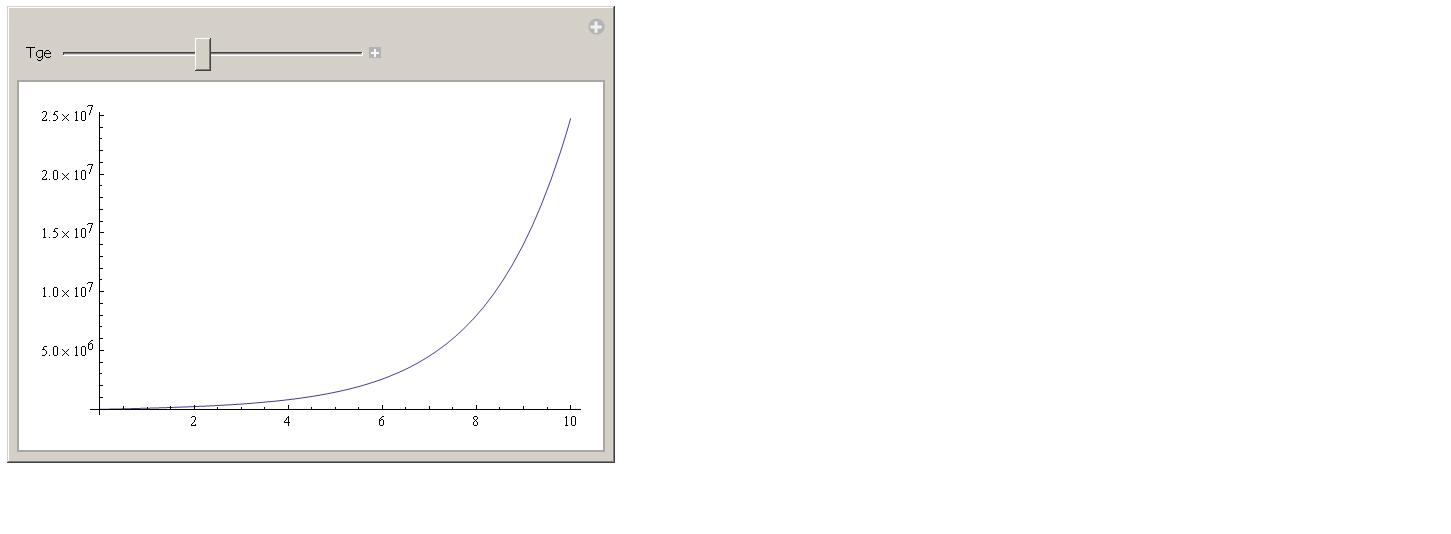Duplicate or not, but the equation, eq1, is too complex for Mathematica to be solved analytically. Anyway I would first look at the solution. First make the integration in the left-hand part of eq1:
0.013*I0*(Integrate[Exp[x/Attc], {x, 0, Tc}] +
Integrate[Exp[x/Attc], {x, Tge, Tge + 2 Tc}]*Exp[Tc/Attc]*
Exp[Tge/Attge])/(0.019*I0*
Integrate[Exp[x/Attge], {x, Tc, Tc + Tge}]*
Exp[Tc/Attc]) // Simplify
(* (0.684211 E^(-0.934783 Tc) (-2. + 2. E^(0.5 Tc) +
E^(0.5 Tc + 0.934783 Tge) (-2. + 2. E^(1. Tc))))/(-2.3 +
2.3 E^(0.434783 Tge)) *)
and then plot it:
Attge = 2.3;
Attc = 2.0;
Manipulate[
Plot[(0.68 E^(-0.935 Tc) (-2.` + 2.` E^(0.5` Tc) +
E^(0.5` Tc + 0.935 Tge) (-2. + 2.` E^(1. Tc))))/(-2.3 +
2.3 E^(0.435 Tge)), {Tc, 0, 10}], {Tge, 1, 50}]
You should be able to see the following:  As one can see, the left-hand part of eq1 very rapidly increases with Tc, if Tge is in the range of few tens. If this is OK with you, one can solve the equation numerically:
As one can see, the left-hand part of eq1 very rapidly increases with Tc, if Tge is in the range of few tens. If this is OK with you, one can solve the equation numerically:
Clear[Tge];
eq1 = (0.68 E^(-0.935 Tc) (-2.` + 2.` E^(0.5` Tc) +
E^(0.5` Tc + 0.935 Tge) (-2. + 2.` E^(1. Tc))))/(-2.3 +
2.3 E^(0.435 Tge)) == 0.66;
lst = Table[{Tge, FindRoot[eq1, {Tc, Tge}][[1, 2]]}, {Tge, 0.1, 10,
0.05}];
ListPlot[lst, AxesLabel -> {"Tge", "Tc"}]
You get the following plot:  Finally, if I would be at your place and need an analytic solution, I would fit it to some reasonable function. Like this, for example:
Finally, if I would be at your place and need an analytic solution, I would fit it to some reasonable function. Like this, for example:
Clear[a, b];
ff = FindFit[lst, a*x*Exp[-b*x], {a, b}, x];
Show[{
ListPlot[lst, AxesLabel -> {"Tge", "Tc"}],
Plot[a*x*Exp[-b*x] /. ff, {x, 0, 10}, PlotStyle -> Red]
}]
You should see the following:  The red line shows the fitting function. Have fun!
The red line shows the fitting function. Have fun!

 As one can see, the left-hand part of eq1 very rapidly increases with Tc, if Tge is in the range of few tens. If this is OK with you, one can solve the equation numerically:
As one can see, the left-hand part of eq1 very rapidly increases with Tc, if Tge is in the range of few tens. If this is OK with you, one can solve the equation numerically: Finally, if I would be at your place and need an analytic solution, I would fit it to some reasonable function. Like this, for example:
Finally, if I would be at your place and need an analytic solution, I would fit it to some reasonable function. Like this, for example: The red line shows the fitting function. Have fun!
The red line shows the fitting function. Have fun!